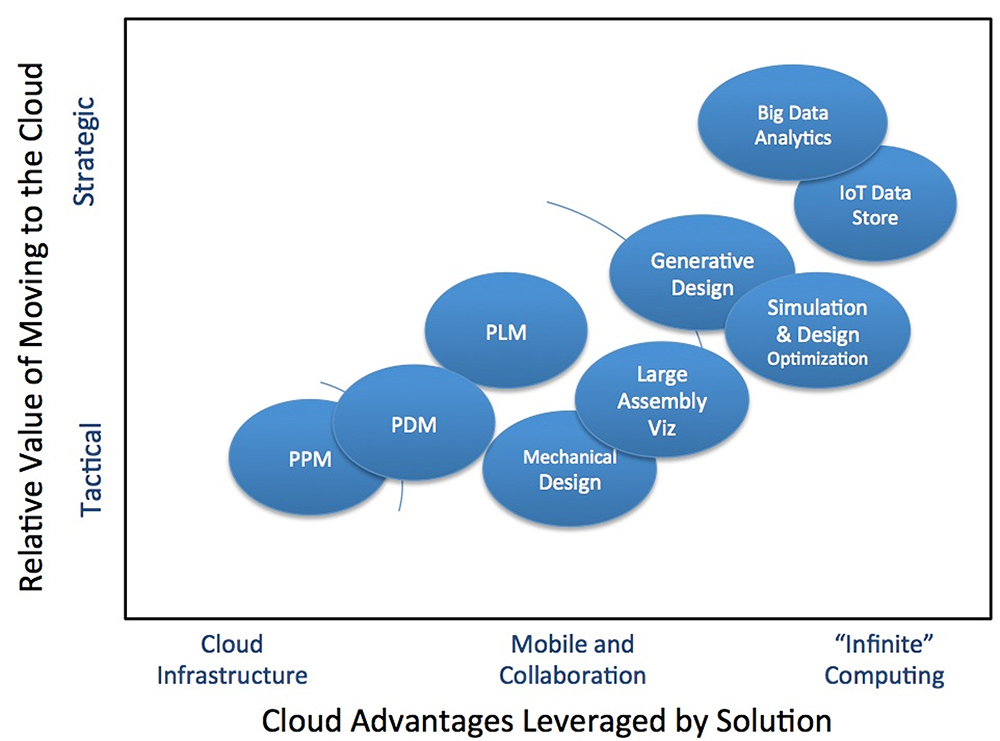Cloud engineering software: more than engineering software on the cloud

Why not the cloud?
Our previous post, “The Subtle Shift to “Why not Cloud?” shares that the view on cloud computing in business is changing. It’s shifting from a question of whether to use the cloud to a question of “why not?”. Our research shows that many businesses are moving beyond the point of merely accepting the cloud as an option to choosing the cloud as their preferred deployment option.
 Jim Brown, Founder and President of Tech-Clarity. (Image and bio courtesy of Tech-Clarity).The cloud isn’t for every company. For as many companies as we find that favor the cloud, we find a similar number that doesn’t allow it. Why the dichotomy? Some companies are prohibited from using the cloud due to industry standards or customer mandates. Others are cautious and prefer to be responsible for their own data security. While some companies feel that security concerns have become better understood and more manageable as the industry has matured, others may point to the increased likelihood of intrusion when the intellectual property of many companies is consolidated in a single location.
Jim Brown, Founder and President of Tech-Clarity. (Image and bio courtesy of Tech-Clarity).The cloud isn’t for every company. For as many companies as we find that favor the cloud, we find a similar number that doesn’t allow it. Why the dichotomy? Some companies are prohibited from using the cloud due to industry standards or customer mandates. Others are cautious and prefer to be responsible for their own data security. While some companies feel that security concerns have become better understood and more manageable as the industry has matured, others may point to the increased likelihood of intrusion when the intellectual property of many companies is consolidated in a single location.
We’ll talk more in a future post about how Service Level Agreements (SLAs), cloud standards, and audit processes can help mitigate security risk. But the reality today is that there are strong opinions on both sides of the discussion. This post will help those that are open to evaluating the benefits of the cloud.
Why cloud?
Why are so many companies becoming cloud advocates? There are a variety of benefits the cloud delivers. We organize them into five categories:
-
- Implementation benefits
-
- Operational benefits
-
- Business benefits
-
- Unique benefits for engineering software
-
- Strategic benefits
The first three are relatively common across different types of software solutions and are likely understood by companies with experience in ERP, CRM or other cloud solutions. They may already have experienced business benefits and the ability to leverage shared resources with dedicated specialists for performance, business continuity, and security. But there is more to consider based on the specific needs of engineers.
Why cloud for product innovation and engineering software?
Let’s focus on the unique benefits that apply more specifically to engineering software. As we say in, exploring cloud options for product innovation and development, “It’s important to differentiate between offerings that simply replace on-premise infrastructure from those that leverage special cloud computing characteristics to deliver previously difficult or impossible solutions.” As you can see in the chart, those unique benefits are often more valuable than the generic cloud value. Let’s take a look at some of them.
Collaborate on the cloud
Product innovation, product development, and engineering are community efforts. Many companies rely on the input of users across the globe and involve third parties, including customers, suppliers, and engineering partners, to develop a successful product.
The cloud is a more natural way to extend computing across these entities and locations. It allows companies to set up a neutral location to share information without having to let others inside their firewall. By providing an easy way to share information, it also helps curtail the all-too-common practice of engineers sending sensitive design data in uncontrolled methods like email and file sharing services like Dropbox.
Provide “infinite” compute
Engineering solutions can require significant compute or memory resources. Processes such as machine learning, generative design, or multi-physics analysis can require large-scale computing power. Most companies, however, only need that power on an intermittent basis and can’t justify having that amount of hardware in-house and underutilized.
The cloud offers access to bursts of effectively limitless compute power without companies having to own, provision, or maintain the hardware. It allows companies to leverage shared high-performance computational resources on an as-needed basis. This brings this scale of computing power to a broader audience so that more than a few specialists can leverage it.
IoT and analytics
Many companies are shifting to more digital, connected business models. They may be connecting with their products in the field with the IoT or collecting manufacturing information via the Industrial IoT. Gathering sensor and other data generate significant data volumes that are difficult or impossible to manage internally, particularly when it includes time-sensitive data that requires redundancy.
The cloud provides effectively unlimited storage with enhanced continuity. This allows companies to collect vast amounts of data in the cloud and run analytics, such as AI. The cloud is particularly well suited to this. It can handle the volume and workload, scaling as needed.
Speaking of scalability
Scalability is not only about computing power. The ability to scale users is a business benefit that has some unique value in supporting product innovation and product development. Program-based or seasonal businesses that experience substantial changes in technical staffing are relatively common. These companies can scale up (and more importantly, down) the number of user licenses as needed, and not have to worry about having too few seats or paying for more than they need.
So why cloud?
The advantages of the cloud span a variety of dimensions with some applying to many types of solutions, but the ones above offer relatively unique value to the engineering software industry. The tactical value of shifting to a software-as-a-service (SaaS) model may be enough to justify the shift financially, but the capabilities above probably eclipse those in business value.
Solutions are now available; it’s time for more companies to take a look.
About the author:
Jim Brown is the founder and President of independent research firm Tech-Clarity. Jim is a recognized expert in enterprise software for manufacturers, with over 25 years of experience in application software, management consulting, and research. He has extensive knowledge about how manufacturers use Product Lifecycle Management (PLM) and other enterprise applications to improve business performance.
Jim is actively researching the value available from new initiatives and technologies including cloud computing, digitalization, product innovation platforms, smart manufacturing, AR, VR, and the IoT in addition to his core research areas which include PLM, quality, service, manufacturing, and more.


